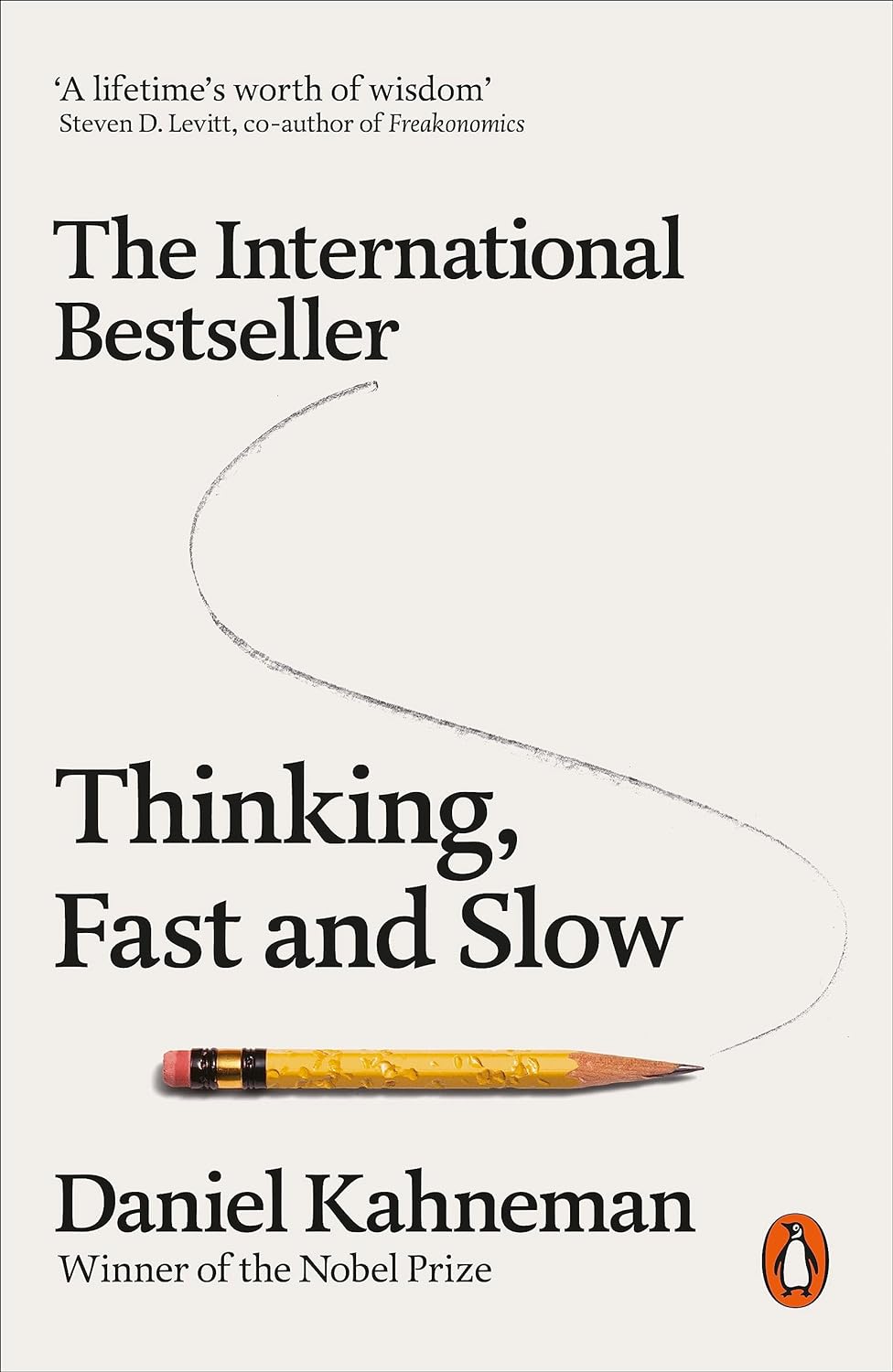Dual Systems of Thinking
Welcome to the captivating world of "Thinking, Fast and Slow" - a fascinating journey into the intricacies of human thought and decision-making. The theme of "Dual Systems of Thinking," masterfully explored by Nobel laureate Daniel Kahneman, is at the core of this book.
Picture your mind as a two-track highway, with each lane representing a different mode of thinking. On one side, we have System 1 - the fast and intuitive lane, effortlessly guiding us through everyday life. This system operates without our conscious control, generating instant reactions and snap judgments. It's the part of our mind that effortlessly recognizes faces, completes familiar phrases, and reacts to sudden dangers with lightning speed. Kahneman describes System 1 as "the emotional, unconscious, and automatic part of our mental life."
On the other side, we find System 2 - the slow and deliberate lane, responsible for deep thinking, analysis, and problem-solving. Unlike System 1, System 2 requires effort and concentration. It's the part of our mind that we activate when we do complex calculations, critically assess arguments, and make deliberate choices. Kahneman describes System 2 as "the thinking and reasoning component of our mental life."
These two systems coexist within us, often working in tandem, but sometimes in conflict. While System 1 operates efficiently, it's susceptible to cognitive biases and heuristics that can lead us astray. System 2, on the other hand, is more reliable and analytical, but it can be lazy and prefers to rely on System 1 whenever possible.
To illustrate the concept further, Kahneman uses real-life examples, such as solving puzzles or encountering unexpected situations. He also highlights the impact of these dual systems on decision-making in various fields, from finance to medicine.
One essential insight from this theme is that our reliance on System 1 can sometimes lead to cognitive errors, but being aware of the interaction between these two systems can help us make better judgments. As Kahneman notes, "The intuitive system is more influential and more error-prone than we think."
Cognitive Biases and Heuristics
Authored by Nobel laureate Daniel Kahneman, this book uncovers the hidden traps and shortcuts that our minds unknowingly fall prey to, affecting our decisions in ways we never imagined.
Cognitive biases are like optical illusions of the mind - they create systematic patterns of error in our judgment and perception. Kahneman reveals that these biases are deeply ingrained within us, arising from the inherent workings of our dual thinking systems. He warns, "We are prone to think, take mental shortcuts, and jump to conclusions without a second thought."
One of the most well-known biases discussed in the book is the Availability Heuristic. It leads us to judge the likelihood of an event based on how easily relevant examples come to mind. For instance, after watching news about plane crashes, we may perceive flying as riskier than driving, even though statistics prove otherwise.
Another powerful bias is the Confirmation Bias, which nudges us to seek information that confirms our preexisting beliefs while ignoring evidence that contradicts them. Kahneman points out, "We love to confirm our beliefs and hate to be proven wrong."
In addition to biases, heuristics, mental shortcuts that simplify decision-making, play a significant role. Anchoring is a classic example, where an initial reference point (the anchor) strongly influences subsequent judgments. Whether negotiating salaries or purchasing items, the anchor sets the tone for our decisions.
Throughout the book, Kahneman presents a treasure trove of experiments and research to demonstrate these biases and heuristics in action. From framing effects to overconfidence, each chapter reveals new layers of our mind's complexities.
By understanding these cognitive pitfalls, we can gain greater control over our thought processes and make more informed choices. Kahneman reminds us, "We cannot avoid our biases entirely, but we can become more aware of them."
Rationality vs. Irrationality
At the core of this theme lies the dichotomy between System 1 and System 2 thinking. System 1 operates swiftly and instinctively, making split-second judgments based on intuition and emotion. Kahneman explains, "System 1 is the effortless, automatic part of our mind, while System 2 is the slow, deliberate, and analytical part."
System 2 is the rational, deliberate system that we rely on for logical reasoning and critical thinking. However, it's not always as active as we might believe. "The automatic operation of System 1 often leaves System 2 to do the best it can with the limited information it receives," cautions Kahneman.
Amidst the ebb and flow of these thinking systems, cognitive biases and heuristics arise, revealing our inherent irrationality. Our minds tend to veer towards shortcuts and hasty judgments, leading to errors in perception and decision-making.
One of the prime culprits is the 'Halo Effect,' where a single positive trait of a person or object colors our perception of their overall character or value. Similarly, the 'Sunk Cost Fallacy' persuades us to stick with failing endeavors because we've already invested time or resources, despite its rationality.
Yet, amidst these biases, rationality isn't entirely lost. Kahneman stresses, "The mind is capable of both brilliance and blunders." By cultivating self-awareness and challenging our ingrained biases, we can enhance our decision-making prowess.
Through a captivating blend of real-world examples and groundbreaking research, "Thinking, Fast and Slow" offers a deeper understanding of the push and pull between our rational and irrational tendencies. By exploring this theme, readers gain powerful insights into the complexities of human thought, discovering that rationality and irrationality coexist within all of us.
Anchoring and Adjustment
In this theme lies the concept of anchoring, where our initial exposure to a piece of information heavily influences subsequent judgments. Kahneman explains, "Anchoring is the human tendency to rely too heavily on the first piece of information offered when making decisions."
Imagine you are asked to estimate the population of a city, and before doing so, you're given a random number like 10,000. This anchoring effect will inadvertently skew your estimation towards that number, even if it's completely unrelated to reality. Our minds tend to adjust from this initial anchor rather than starting from scratch.
Kahneman and Tversky's classic experiment demonstrates this phenomenon. They asked participants to estimate the percentage of African countries in the United Nations. Before responding, one group was given a high anchor (e.g., 65%), while the other a low anchor (e.g., 10%). Remarkably, participants' estimates leaned heavily towards the anchor they were given, showcasing the power of this cognitive bias.
The book delves into the concept of insufficient adjustment, where we often fail to adjust far enough from the initial anchor, leading to biased judgments and decisions.
Understanding this phenomenon empowers us to become more aware of our susceptibility to anchoring and make more rational judgments. Kahneman asserts, "When you're aware of the anchoring effect, you're better equipped to recognize its influence on your decision-making."
By challenging ourselves to reevaluate information objectively and anchoring, we can mitigate its influence on our choices and arrive at more balanced decisions.
Through a captivating blend of research and real-world examples, "Thinking, Fast and Slow" offers profound insights into how anchoring and adjustment shape our thought processes. By exploring this theme, readers gain powerful tools to become more adept at recognizing and mitigating the impact of anchoring, ultimately enhancing their decision-making abilities.
Mindfulness and Self-awareness
At the heart of this theme lies the distinction between our two thinking systems: System 1, our intuitive and automatic mind, and System 2, our deliberate and analytical mind. Kahneman explains, "System 1 operates automatically and quickly, with little or no effort and no sense of voluntary control. System 2 allocates attention to the effortful mental activities that demand it."
The crucial aspect of mindfulness and self-awareness is recognizing the interplay between these systems and understanding their respective strengths and limitations. Often, our intuitive System 1 jumps to conclusions based on cognitive biases and heuristics, leading to errors in judgment. However, by cultivating self-awareness and being mindful of our thought processes, we can harness the strengths of System 2 to critically evaluate and override our intuitive biases.
Kahneman highlights the significance of conscious awareness in the decision-making process: "The way to block errors that originate in System 1 is simple in principle: recognize the signs that you are in a cognitive minefield, slow down, and ask for reinforcement from System 2."
Mindfulness empowers us to pause and question our automatic responses, giving us the space to examine our biases and assumptions. By being mindful of our cognitive processes, we can make more rational and well-informed decisions, ultimately leading to better outcomes.
Additionally, the book explores the concept of the "inside view" and the "outside view." The inside view is our tendency to focus narrowly on the specifics of the task at hand, often leading to overconfidence and an unrealistic assessment of our abilities. In contrast, the outside view involves taking a broader perspective by considering similar past experiences and general statistics. Kahneman advises, "In order to achieve a balanced view of reality, you need to take the outside view."
By incorporating the outside view and being mindful of our biases, we can enhance our decision-making and avoid falling into the traps of overconfidence and wishful thinking.
"Thinking, Fast and Slow" is a compelling journey into the depths of our minds, urging us to cultivate mindfulness and self-awareness. Through captivating stories and thought-provoking insights, Kahneman invites us to embrace a more balanced and mindful approach to decision-making.
As you embark on this enlightening adventure, you'll discover the transformative power of mindfulness, self-awareness, and a deeper understanding of the intricate workings of your mind. Armed with these tools, you'll be better equipped to navigate life's challenges, make wiser choices, and unleash the full potential of your cognitive abilities. So, dive into the world of "Thinking, Fast and Slow," and unlock the secrets of mindfulness that will elevate your thinking and reshape your perspective forever.

